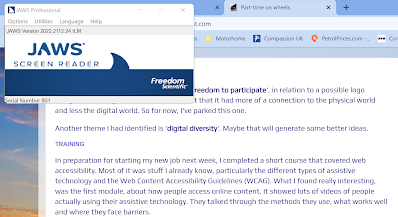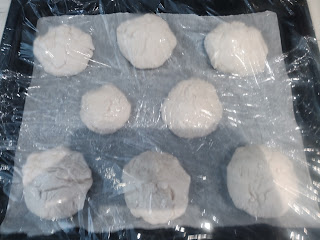I rang a pub yesterday to find out whether they are accessible or not. As I asked the question, it occurred to me that it was a somewhat vague question to ask. I mean, what makes a place accessible or inaccessible for me might be different than for other people, even with similar conditions. So here are some thoughts on accessibility of places.
Getting in
For a wheelchair user, getting into the venue is usually the first hurdle. Steps make this pretty much impossible, so some kind of ramp is usually used to give buildings level entry. Ramps vary though. There are the kind of ramps that have actually become part of the fabric of the building... concrete, sensible and compliant slope (1 in 12 or less) and that generally bring you into the main entrance of the building. There are other permanent ramps that are installed somewhere to enable wheelchair users to get in, though maybe not at the same entrance as everyone else. Then there are the temporary/portable ramps, which may or may not have a usable gradient. I've been presented with some that are at a 45o angle and downright impossible to use.
I believe that the vast majority of venues, if they really wanted to, could provide some form of level entry. Many blame listed building status for not providing it but I've been to many historic houses, old buildings and so on, that have managed to adapt their entrance area and allow wheelchair users to get in.
To be fair though, I have also been to some places, like the church where my son recently got married, where I fail to see how they could provide safe level entry to the grounds. This is usually due to being built into a very steep hill and not having enough space. I have more sympathy when this is the case, rather than just blaming listed building status and the local council.
Of course, there is one option I haven't mentioned... and that is the alternative entrance. This can work well but not if it takes you, e.g. through the bins in a rear yard, then through a busy kitchen with people running around with knives and hot pans, to get you into the restaurant.
Getting into a building shouldn't be stressful, scary, make you feel like an inconvenience or reliant on another person for assistance.
Getting around
Many people assume that if you can get into the building, that's the job done. Not so! Moving around is also important. This means that the doorways can't be narrower than my wheelchair. I have to physically fit through. It also means not having to negotiate steps once inside.
Of course, there are ways of making a multilevel building accessible. Lifts are the obvious... either a normal lift or one of those platform lifts that gets you there eventually. Stairlifts are an option too but often don't work for people who use heavy electric wheelchairs or scooters. We were at Castle Howard yesterday and they have a platform stairlift. You wheel on and then it takes you up the stair case just like a normal stairlift. It was painfully slow but it did the job and was probably cheaper and easier to install than a lift (in a listed building).
Once we've dealt with physical barriers such as doors and stairs, other things that make moving around difficult include:
- Layout - are tables and chairs blocking the walkways so that you have to keep asking people to move to allow you through? Are the aisles too narrow? Do they have items such as temporary promotions blocking them?
- Flooring - thick pile carpet is really hard work to wheel on, rather like wading through knee-deep treacle! Uneven flooring and things like cables and hoses can also make it difficult. My dream is nice smooth tiles, though flat pile carpet is also nice.
- Queuing systems - it used to just be the post office that used those zigzag queues but now they are everywhere. It stands to reason that the posts (including their bases) need to be far enough apart to allow a wheelchair to pass between them.
Accessible toilets
This is the most important thing for me after getting into the building, and yet it is the thing nobody ever thinks about. I get that with some places. Why would you need to go to the toilet on a trip to the supermarket? Most people don't. I often do.
Pubs and restaurants though? Come on!!! Most people, when inputting liquid at the top will eventually have to empty it out at the bottom. Me more than most, it seems.
An accessible toilet is essential, but what do I need? I preferably need to be able to go in with my wheelchair. I can walk enough to go in without it but I worry about my chair or my bag or phone being stolen. I can't walk and carry, so I have to leave everything outside.
Rails are extremely important. At a push, I can fall onto the toilet without them but I can't get back up. If there are no grab rails, I have to use something else to pull myself up... something that wasn't intended for that purpose. I don't want to break stuff - your fittings or my body.
A lowish mirror and clean shelf is also handy for when I need to self-catheterise. This is nearly always forgotten. Another thing that is forgotten, is that incontinence pads can be huge - way bigger than sanitary towels, more like nappies - so a bin to dispose of them is useful. It is handy, given that some disabled people can't use their feet at all, if the bin isn't foot pedal only. It also helps if it can be reached from the toilet. The opposite side of the room presents some difficulties.
No dogs allowed/dog friendly
My heart sort of sinks a little when I see either of these signs on a door. Let me explain why.
Many indoor venues have a sign that bans all dogs. The sensible ones then say underneath, "except assistance dogs". There are very few places that have a legal right to ban assistance dogs. Even those that do have that legal right, often choose not to exercise it. Basically the only reason for banning assistance dogs is if you have ground nesting birds that could be harmed by the presence of a dog.
I love birds! They have birds at Potteric Carr in Doncaster. I've been there years ago, in the bird hides, watching the birds in their natural environment. It was amazing! They could legitimately ban all dogs. However, they choose to allow assistance dogs. I, however, choose not to take Liggy there. I'm pretty sure she would be fine but she hasn't had much practice with bird work and I'm conscious that she's a labrador retriever and something deep inside her might make her inclined to pull towards birds. I don't need to go to such a place to live a normal independent life. I'm happy to do other things and leave the birdies in peace.
I'm beginning to lose count of the number of places that ask us on arrival whether we intend to view the house/museum/shop/etc separately because dogs aren't allowed. I usually start by stating that she's an assistance dog but even then, it's amazing how many staff members don't know the law or their own policies. Even yesterday, the ticket lady had to go and check with a manager, having told us she very much doubted that assistance dogs were allowed into the house. She came back quite pleased that she would now know the answer... but no apology for the stress, embarrassment or confusion caused. And that was in spite of it being very clear on their own website that no dogs were allowed in the house, except assistance dogs.
Some people still use the sign that says... except guide dogs. I generally assume that covers all assistance dogs but I find the sign a little irritating. It adds to the general misconception that all assistance dogs are with blind people.
You would expect me to prefer places that are "Dog Friendly", I guess. Well, it depends what it is. If it's an outdoor attraction, gardens, park, informal cafe, etc, then yes, dog friendly is usually great. When it comes to restaurants, pubs, other places where I'm going to expect Liggy to lie quietly, be on best behaviour and transfer situational rules across, then I prefer to be seated away from pet dogs.
It's not that I don't like dogs. Far from it! I love dogs! However, Liggy gets to go into places that don't want dogs and that comes with expectations on her behaviour. So, for example, when we sit down to eat a meal, she always (and mean always) has to lie quietly on her bed and stay still. She does this really well and I am frequently complimented on her behaviour in restaurants because her training is very clear. If I then have to sit near someone else with another dog, that might be playful, aggressive, just have different food rules, etc, then Liggy might be tempted to relax her excellent meal time behaviour. That would be fine in that dog friendly place but she doesn't know that different places have different rules, even for the same situation. So it is just easier if we can be separate for those activities.
Also, dog friendly places often have a dog friendly area and a dog-free area. Many are good and let us sit in the dog-free area, which helps me a lot, but some don't understand why I want to sit away from other dogs. They don't understand that Liggy isn't a pet. Sure, she has times to be a normal dog and she is very well behaved around other dogs but she is different. She is a working dog and carries extra responsibilities and expectations.
Euan's Guide
So having talked a little about what accessibility means for me, I want to recommend a review site. Euan's Guide is kind of like Trip Advisor for disabled people. It is full of reviews of different places, all done by or on behalf of disabled people. I've been reviewing for them for a while now and I use it a lot to plan visits and days out.
One of the things I really like about it, is that each review tells you about the reviewer and their disability. So I often look for information given by other wheelchair users and people with assistance dogs.
If you have a disability, please consider reviewing places. The more people write reviews, the better it becomes. All reviews get moderated before publishing, so you don't have to worry about whether it was okay to write this or that. Just say what you found and how you managed, be honest and know that others will find it useful.


















































